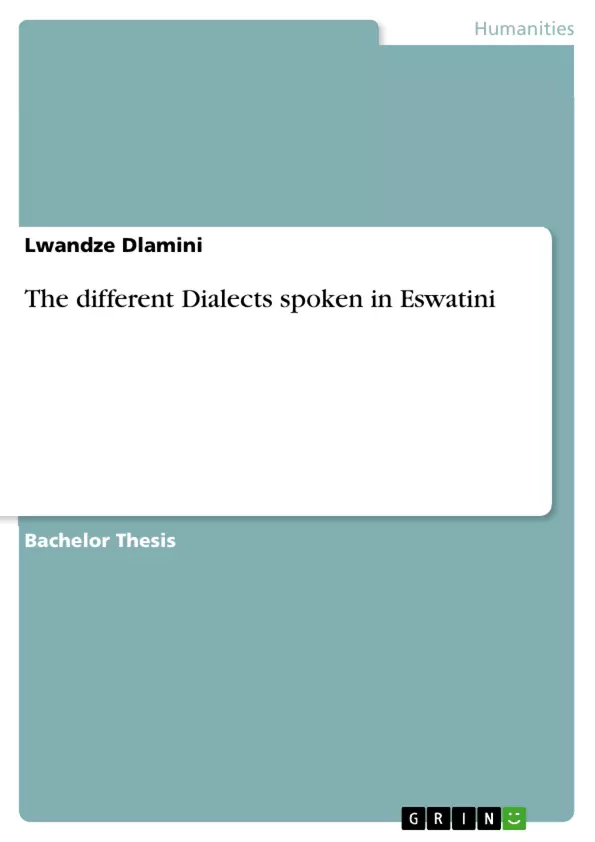With a sociolinguistic scope, the present research work is aimed to investigate and examine SiSwati variations/dialects in the four regions of Eswatini (Hhohho, Lubombo, Shiselweni and Manzini).
Since dialectal study is comparative, the SiSwati texts in the four regions have been compared to a standardized version of the language, that is, the SiSwati variant that is being taught in schools. The major linguistic focus of this study is morphological variation, lexical variation and syntactical variation. Four speakers, from the four different regions have been interviewed for this study. The results indicated that SiSwati, just like any other language spoken by a large speech community, has variations. Major linguistic differences have been noted in the construction of words, the choice of vocabulary used by the speakers, and the construction of sentences.
Many scholars, like Khumalo have deliberated on the dialects of Emaswati. These studies mainly focus on the phonological variations. So far, little attention has been paid to awareness regarding other areas of dialect variation such as lexical variation and grammatical variation. This study will present the morphological, lexical and syntactic differences of the dialects of SiSwati in the different regions of Eswatini. The effort of this study is to research the different dialects is an effort to understand the differences in the society. It will identify the possible similarities and differences between the lexical items of these dialects and the standard SiSwati, also, with the aim of showing peculiarities as far as their morphologic systems are concerned.
Table of Contents
- Dedication
- Acknowledgements
- Abstract
- 1.0 Introduction
- 1.1 Purpose of the study
- 1.2 Scope of Study
- 1.3 Method of data collection
- 1.4 Literature review on dialectology
- 2.0 The Shiselweni dialect
- 2.1 Morphophonemic variation
- 2.2 Lexical variation
- 2.3 Syntactic variation
- 3.0 The Manzini dialect
- 3.1 morphophonemic variation
- 3.2 Lexical variation
- 3.3 Syntactic variation
- 4.0 Lubombo (Lomahasha) Dialect
- 4.1 Morphophonemic variation
- 4.2 Study of Lexical variation
- 4.3 Syntactic Variation
- 5.0 Hhohho Dialect
- 5.1 Morphophonemic Variation
- 5.2 Lexical Variation
- 5.3 Syntactic Variation
- 6.0 Conclusion
- 6.1 Recommendations
- REFERENCES
- APPENDIX A
- APPENDIX B
- APPENDIX C
- APPENDIX D
- APPENDIX E
Objectives and Key Themes
This research study investigates and examines the variations and dialects of SiSwati in the four regions of Eswatini: Hhohho, Lubombo, Shiselweni, and Manzini. The study compares the SiSwati texts from these regions to a standardized version of the language taught in schools, focusing on morphological, lexical, and syntactical variations. The research utilizes interviews with speakers from each region to gather data.
- Analyzing and comparing SiSwati variations across different regions of Eswatini.
- Examining morphological, lexical, and syntactical differences in SiSwati dialects.
- Investigating the impact of geographical location and social factors on language variation.
- Providing insights into the linguistic diversity of SiSwati within Eswatini.
- Contributing to the understanding of SiSwati language variation and standardization.
Chapter Summaries
The introduction provides background information on SiSwati, its classification within the Niger-Congo language family, and its relationship to Zulu. It also discusses the language policy in Eswatini and the role of SiSwati in the educational system. The study then explores the Shiselweni dialect, analyzing its morphophonemic, lexical, and syntactic variations. The Manzini dialect is examined in a similar fashion, highlighting key linguistic differences in word construction, vocabulary, and sentence structure. The Lubombo (Lomahasha) dialect is then discussed, focusing on its unique features in morphology, lexicon, and syntax. Finally, the Hhohho dialect is investigated, highlighting its distinctive characteristics. Each chapter provides insights into the linguistic variation and diversity within the SiSwati language.
Keywords
This research study focuses on SiSwati language variation, dialectology, morphological variation, lexical variation, syntactic variation, sociolinguistics, linguistic diversity, Eswatini, Shiselweni, Manzini, Lubombo, Hhohho, standardized language, and regional dialects. The study aims to contribute to the understanding of SiSwati language variation and standardization within the context of Eswatini.
- Quote paper
- Lwandze Dlamini (Author), 2020, The different Dialects spoken in Eswatini, Munich, GRIN Verlag, https://www.grin.com/document/1436661



